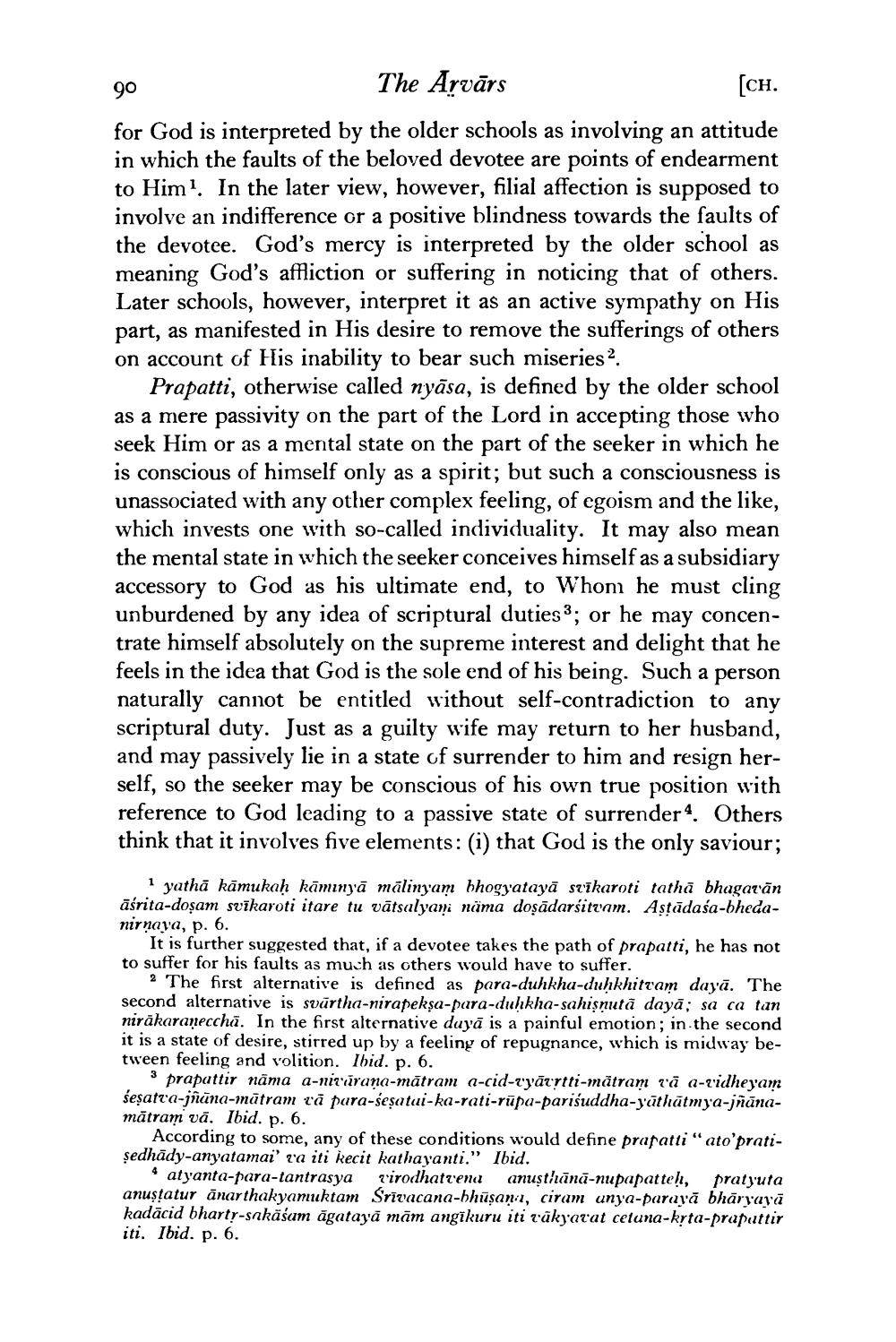________________
90 The Arvārs
[CH. for God is interpreted by the older schools as involving an attitude in which the faults of the beloved devotee are points of endearment to Him?. In the later view, however, filial affection is supposed to involve an indifference or a positive blindness towards the faults of the devotee. God's mercy is interpreted by the older school as meaning God's affliction or suffering in noticing that of others. Later schools, however, interpret it as an active sympathy on His part, as manifested in His desire to remove the sufferings of others on account of His inability to bear such miseries?
Prapatti, otherwise called nyāsa, is defined by the older school as a mere passivity on the part of the Lord in accepting those who seek Him or as a mental state on the part of the seeker in which he is conscious of himself only as a spirit; but such a consciousness is unassociated with any other complex feeling, of egoism and the like, which invests one with so-called individuality. It may also mean the mental state in which the seeker conceives himself as a subsidiary accessory to God as his ultimate end, to whom he must cling unburdened by any idea of scriptural duties 3; or he may concentrate himself absolutely on the supreme interest and delight that he feels in the idea that God is the sole end of his being. Such a person naturally cannot be entitled without self-contradiction to any scriptural duty. Just as a guilty wife may return to her husband, and may passively lie in a state of surrender to him and resign herself, so the seeker may be conscious of his own true position with reference to God leading to a passive state of surrender 4. Others think that it involves five elements: (i) that God is the only saviour;
1 yathā kāmukah kāminy'ā mālinyam bhogyatayā svīkaroti tathā bhagavān āśrita-dosam svīkaroti itare tu vātsalyani nüma doşādarsitunam. Astādaśa-bhedanirnaya, p. 6.
It is further suggested that, if a devotee takes the path of prapatti, he has not to suffer for his faults as much as others would have to suffer.
2 The first alternative is defined as para-duhkha-duhkhitram dayā. The second alternative is svārtha-nirapeksa-para-duhkha-sahişnutā dayā: sa ca tan nirākaranecchā. In the first alternative duyā is a painful emotion; in the second it is a state of desire, stirred up by a feeling of repugnance, which is midway between feeling and volition. Ibid. p. 6.
prapattir náma a-nitrirana-matram a-cid-z'yārrtti-mätram tā a- 'idheyam seşatva-jñüna-mātram tā pura-sesatui-ka-rati-rūpa-parisuddha-yāthātmya-jñānamātram vā. Ibid. p. 6.
According to some, any of these conditions would define prafatti “ato'pratiședhādy-anyatamai' za iti kecit kathayanti." Ibid.
4 atyanta-para-tantrasya Tirodhattena anusthānā-nupapatteh, pratyuta anustatur ānarthakyamuktam Srīvacana-bhūşanı, ciram unya-paravā bhāryavā kadācid bhartr-sakäśam āgatayā mām angikuru iti rakyatat cetuna-kyta-praputtir iti. Ibid. p. 6.




